Introduction: In this article, Gena Philibert-Ortega searches old newspapers to learn more about a fascinating aspect of Nellie Bly’s journalism career: she was the first female war correspondent during World War I. Gena is a genealogist and author of the book “From the Family Kitchen.”
Investigative reporter Elizabeth Cochran Seaman (1864-1922), better known by her pen name Nellie Bly, is well known for her investigative reporting into the deplorable conditions at the Women’s Lunatic Asylum at Blackwell Island in 1887 (she faked insanity to get in), and her record-breaking 72-day trip around the world (which captivated the world’s attention) in 1889-90. Her reporting went beyond those two investigations, however, and included reporting on 20th century events like the fight for women’s suffrage and World War I.
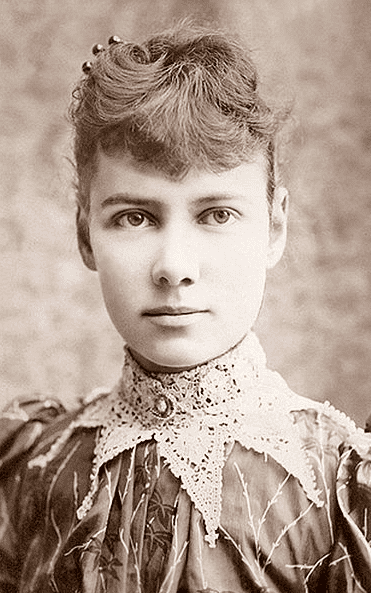
War Correspondent: On the Front Lines
So much attention is given to Nellie’s early journalism career that her later years are almost completely forgotten. While she was doing important investigative reporting in those early years of her career, she is lesser known for being one of the first women war correspondents. In 1914, Nellie fled to Austria due to financial problems with her deceased husband’s company. She found herself with the opportunity to report on the Great War from the front lines. She was the first woman to report from the eastern front.
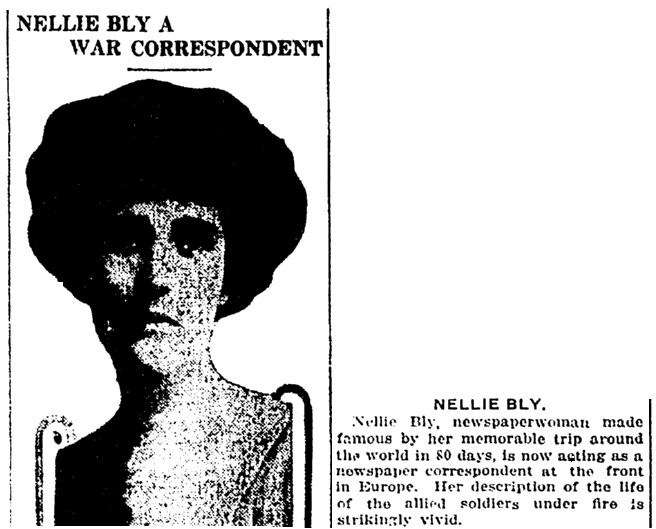
In this dispatch from December 1914, Bly reports on what she witnesses and experiences as she spends time with Austrian soldiers on the front lines.
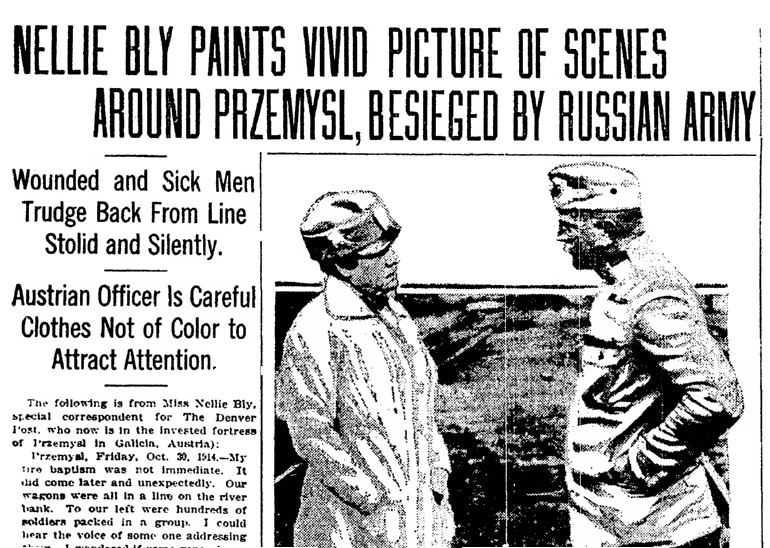
The caption of the photo accompanying this article reads:
“This photograph of Nellie Bly, the famous American newspaper woman, now at the front in Poland for The Denver Post, was taken as she was interviewing an Austrian officer near the operations in Poland, just beyond the staff and press headquarters at the beleaguered fortress of Przemysl. – Copyright, 1914, International News Service.”
In a scene reminiscent of a recent movie about a female war reporter*, the commanding officer takes Bly to task for wearing the color blue on the front lines:
“As I must walk, I pulled off my ‘officer’s’ coat. I had on my soldier’s gray skirt and blue sweater. I was told it was soldier’s blue, but Colonel John evidently thought otherwise. ‘Oh, Miss Bly, you can’t go in that!’ he cried. ‘The Russian shoots everything he can see. That blue is visible.’ ‘Not more so than the jackets of those Hungarians,’ I replied, pointing to a troop who was just mounting and galloping off. The colonel was not convinced. I was to walk in his group, and he did not intend to have his group fired upon.”
Bly’s reporting of the front lines is filled with vivid descriptions, such as this report on the soldiers she sees as they travel:
“A continuous, straggling stream of sick and wounded soldiers was always coming toward us. Sometimes they saluted, more often they staggered unconsciously and forlornly on, their sunken eyes fixed pathetically on the west, blind to their surroundings, their ears deaf to the near and ceaseless thundering of cannons, their nerves dead to the awful whizzing of the granards [sic] as they whirled above our heads, so near, yet never visible to the eye.”
These reports gave Americans first-hand knowledge of what was happening in the war, three years before they would join the conflict.
Nellie was not the world’s first female war correspondent – that honor goes to Irish-Canadian journalist Kit Coleman, who reported from Cuba during the Spanish-American War – but Bly’s WWI reporting led to even more women reporting from the front lines during World War II.**
Nellie did not report the whole time she lived in Europe; she spent the rest of her time working for charitable efforts for Austrian widows and orphans.***
Back to the United States
On 30 January 1919, Elizabeth Cochran Seaman filled out an Emergency Passport Application in Paris. After five years overseas, it was time to go home. Her passport application provides information about her life abroad, including that her occupation was “writer” and she was living at the Palace Hotel in Paris. Her photo is that of an adventurous reporter who had spent her life dedicated to telling stories. And across that photo she signed herself Nellie Bly.****
Bly’s reporting career didn’t end with World War I. When she returned to the United States from Europe, she was broke. Luckily, she was offered a job with the New York Evening Journal. Her regular column for that paper included everything from advice to helping those less fortunate, like orphaned children.
Her Last Deadline
Only three years after returning home, on 27 January 1922, Elizabeth Cochran Seaman AKA Nellie Bly passed away in New York from pneumonia. The contents of her will were made known to the public three months later, with Austrian money, stocks, and a brooch (given to her by the Queen of Belgium) to go to a Vienna man, Oscar Bondy, whom she had lived with while in Europe during World War I. Stocks and jewelry also were to be given to her brother, her niece, and her ward. Unfortunately, the value of her estate may not have been worth much when she died. Although she had married a millionaire and had been president of his company prior to World War I, her later life was lived in a hotel with her small income from writing to sustain her.
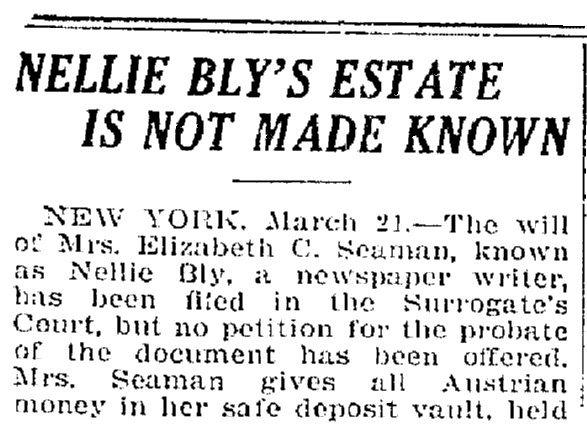
Nellie Bly is buried in Woodlawn Cemetery in New York City. Her unmarked grave was marked in 1978 by the New York Press Club.
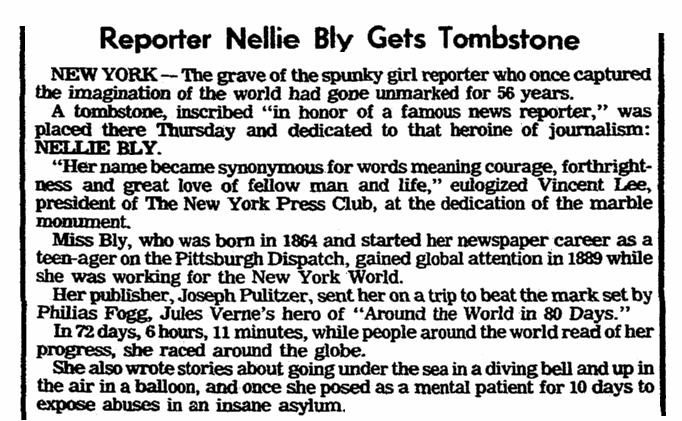
Her ambition and quest for truth continue to be an inspiration today.
Note: An online collection of newspapers, such as GenealogyBank’s Historical Newspaper Archives, is not only a great way to learn about the lives of your ancestors – the old newspaper articles also help you understand American history and the times your ancestors lived in, and the news they talked about and read in their local papers. Did any of your ancestors serve in – or report on – World War I? Please share your stories with us in the comments section.
———————–
* In the movie Whiskey Tango Foxtrot, Tina Fey’s character is ordered to camouflage her bright orange backpack by a commanding officer.
** “Kit Coleman,” Wikipedia (https://en.wikipedia.org/wiki/Kit_Coleman: accessed 2 May 2017). The United States accredited nearly 140 women war correspondents during World War II according to the film No Job for a Woman (http://nojobforawoman.com/videos/no-job-for-a-woman/: accessed 2 May 2017).
*** Goodman, Matthew. Eighty Days: Nellie Bly and Elizabeth Bisland’s History-Making Race Around the World. New York: Ballantine Books Trade Paperbacks, 2014.p. 371.
**** Elizabeth Cochrane Seaman [alias Nellie Bly]. Ancestry.com. U.S. Passport Applications, 1795-1925 [database on-line]. Lehi, UT, USA: Ancestry.com Operations, Inc., 2007. National Archives and Records Administration (NARA); Washington D.C.; NARA Series: Emergency Passport Applications, Argentina thru Venezuela, 1906-1925; Volume #: Volume 158: Paris, France.

Elizabeth Jane Cochran (Nellie Bly) is my great aunt. I’m looking at the photo in Poland during WWI — she looks exactly like my sister.
How great is that?! She was such an inspirational woman. I hope you’re sharing some of her life story with your family. Thanks for sharing that information with us. –Gena
Thanks for this! Was trying to find a good article about it.
Thank you Ashley! There are some great books about Nellie. If you search WorldCat you can find them.–Gena